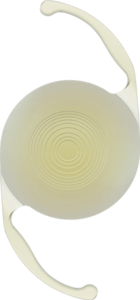What is a cataract?

A cataract is a clouding of the natural lens of the eye. The lens sits just behind the iris and pupil in the front of the eye. Its function is to focus the light that enters the eye onto the retina in the back of the eye, much like the lens of a camera focuses an image onto the film or digital sensor. The lens is constantly growing throughout a patient’s life. New lens proteins get packed on top of old proteins in the center of the lens, where eventually, they run out of space and the orderly arrangement of proteins that is required to keep the lens clear becomes disordered and the lens becomes cloudy. Cataract formation is a common consequence of aging. It happens to all patients, however, at different rates of change. Cataracts can also form due to eye trauma, the use of certain medications such as steroids, diseases such as diabetes, a family history of cataracts, smoking, previous eye surgery, and exposure to the sun. Babies are even born with cataracts.
What are the symptoms of a cataract?
Early on, cataracts may cause little or no problems. As they grow, individuals will often notice blurred vision, glare from lights when driving at night or from the sun, difficulty reading small print, dimming vision, double vision in one eye, and faded colors. These symptoms will quite often interfere with a person’s daily activities of life. A cataract can only be determined to be the cause of a person’s visual problems during a complete eye exam with an ophthalmologist.






How are cataracts treated?
There are no medications or eye drops to clear a cloudy lens. The only way to treat a cataract is with surgery. All cataracts do not require surgery right away. In some cases of early cataracts, a change in eyeglass prescription is all that is needed to improve the vision. But, as a cataract progresses, eventually changing glasses will no longer help and surgery is needed. Cataracts do not need to be “ripe” before surgery can be performed. As long as a cataract is present and person is having symptoms of poor vision that are interfering with their daily activities, they can have surgery.
What is cataract surgery?
Cataract surgery is basically an exchange of the cloudy natural lens for a clear artificial lens implant. Fortunately, cataract surgery is an extremely safe and effective procedure that is performed in an outpatient surgical center. It requires no overnight hospital stay and only takes a few minutes to perform under a local anesthetic with mild intravenous sedation. There is usually no pain at all during or after surgery and vision is restored almost immediately. If a patient has cataracts in both eyes, one eye is operated upon at a time, usually with 1-2 weeks between surgeries. During the surgery, a tiny incision is created at the edge of the cornea and the lens is liquefied using high frequency sound waves and removed by careful suction in a procedure called phacoemulsification. Femtosecond laser, a “premium” service with an additional out of pocket cost, is also offered to assist with the fragmentation or breaking up of the cataract. A number of laser pulses are applied to the lens in a predetermined pattern to allow the surgeon to remove the lens matter using very low phacoemulsification power. The replacement intraocular lens is then inserted. Most intraocular lenses are made of soft acrylic and rolled up and inserted through the same tiny incision used to remove the cataract. In the vast majority of cases, no sutures are needed to close the incision. Patients are able to go home just minutes after the surgery is over.
What options are available for intraocular lenses?
All cataract surgery patients are implanted with an intraocular lens (IOL) at the same time as their cataract is removed. Without an IOL, patients would need to wear extremely thick glasses or a contact lens in order to see. An IOL replaced the natural lens and performs the same job of focusing images onto the retina. Prior to surgery, all patients will have several measurements of their eyes taken in order to determine the correct power and type of implant they need. Thankfully, there are many IOL choices available to patients today. Our cataract surgeon will explain all the options to each patient, as it is a very personal decision. There are three basic types of IOLs:
Monofocal IOL

This type of lens has been in use for over 50 years. It gives a patient excellent distance OR near vision (but not both). Most patients choose a lens for distance vision and will use reading glasses to correct their near vision. Some patients may also choose to avoid using glasses by opting for “monovision” where one eye has a monofocal lens for distance vision and the other eye has a monofocal lens for near vision. If a patient with astigmatism chooses a monofocal IOL, they will also probably need glasses for most distance and near viewing. This type of lens is typically covered by all insurances.
Toric IOL

This is one of the “premium” lenses available. This lens is a special type of monofocal IOL that also corrects astigmatism. Patients with astigmatism have corneas that are not round like a basketball, but distorted like a football. Astigmatism can be corrected with glasses, but if a toric IOL is used after cataract surgery, glasses are usually needed only for near (OR distance) vision. This type of lens is NOT covered by insurance and requires an additional out-of-pocket fee.
Multifocal IOL

This is also a “premium” lens. A multifocal lens can focus distance AND near images, greatly reducing a patient’s need for any glasses after surgery. There are also toric multifocal lenses available for patients with astigmatism. These “premium” type of lens is NOT covered by insurance and requires an additional out-of-pocket fee.
What happens after surgery?
Vision may be cloudy immediately after surgery, but usually begins to clear by the next morning. Eye drops are used for several weeks to help the eye heal and to prevent infection. Patients usually have a follow-up appointment with their surgeon within the first week at our offices. In most cases, further follow-up appointments are scheduled at about 2 and 4 weeks after surgery. A prescription for new eyeglasses is usually given at the last appointment, if glasses are needed.
